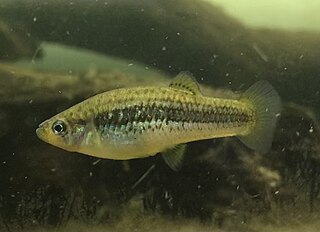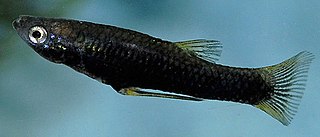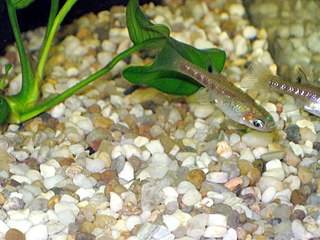
The Poeciliidae are a family of freshwater fishes of the order Cyprinodontiformes, the tooth-carps, and include well-known live-bearing aquarium fish, such as the guppy, molly, platy, and swordtail. The original distribution of the family was the Southeastern United States to north of Río de la Plata, Argentina, and Africa, including Madagascar. Due to release of aquarium specimens and the widespread use of species of the genera Poecilia and Gambusia for mosquito control, though, poeciliids can today be found in all tropical and subtropical areas of the world. In addition, Poecilia and Gambusia specimens have been identified in hot springs pools as far north as Banff, Alberta.

The western mosquitofish is a North American freshwater fish, also known commonly, if ambiguously, as simply mosquitofish or by its generic name, Gambusia, or by the common name gambezi. Its sister species, the eastern mosquitofish is also referred to by these names.

Poecilia is a genus of fishes in the family Poeciliidae of the order Cyprinodontiformes. These livebearers are native to fresh, brackish and salt water in the Americas, and some species in the genus are euryhaline. A few have adapted to living in waters that contain high levels of toxic hydrogen sulfide and a population of P. mexicana lives in caves.
The widemouth gambusia is a species of fish in the family Poeciliidae of the order Cyprinodontiformes. It is endemic to Mexico, specifically to the Baños del Azufre near Teapa, Tabasco. The Baños del Azufre are sulfidic springs that contain high concentrations of toxic hydrogen sulfide. This prevents most animals from living in them; the only other fish found in the toxic sections of Baños del Azufre is the sulphur molly.

Rainbowfishes are small, colourful freshwater fishes belonging to the family Melanotaeniidae, found in northern and eastern Australia, New Guinea, Sulawesi and Madagascar.

The eastern mosquitofish is a species of freshwater fish, closely related to the western mosquitofish, Gambusia affinis. It is a member of the family Poeciliidae of order Cyprinodontiformes. The eastern mosquitofish is native to the eastern and southern United States from Florida to Pennsylvania and inland to Alabama and Tennessee, while the western mosquitofish has a larger distribution throughout the United States.
The San Marcos gambusia is a likely extinct species of Gambusia from the family Poeciliidae that was found only in the San Marcos Springs of Central Texas. The fish has not been seen since 1983.
George Sprague Myers was an American ichthyologist who spent most of his career at Stanford University. He served as the editor of Stanford Ichthyological Bulletin as well as president of the American Society of Ichthyologists and Herpetologists. Myers was also head of the Division of Fishes at the United States National Museum, and held a position as an ichthyologist for the United States Fish and Wildlife Service. He was also an advisor in fisheries and ichthyology to the Brazilian Government.

The Clear Creek gambusia is a species of fish in the family Poeciliidae endemic to the United States, particularly Menard County, Texas.

Gambusia hurtadoi, also known as crescent gambusia, is a species of fish in the family Poeciliidae. It is endemic to Chihuahua in Mexico, where it is known as guayacon de Hacienda Dolores. It grows to 3.5 cm (1.4 in) total length. The species was described in 1957 by Carl Leavitt Hubbs and Victor G. Springer with the type locality given as El Ojo de la Hacienda Dolores, 7 miles south of Jiminez, Chihuahua, the spring to which this species is endemic. Hubbs and Springer honoured the Mexican Leopoldo Hurtado Olin of the Departamento de Economía in Chihuahua for his assistance during their collecting expedition to Chihuahua in June 1951. Hurtado Olin also informed Hubbs and Springer of the location of El Ojo de la Hacienda Dolores.

The sulphur molly, locally known as molly del Teapa, is an endangered species of fish in the family Poeciliidae. It is endemic to Mexico, specifically to the Baños del Azufre near Teapa, Tabasco. The Baños del Azufre are sulfidic springs that contain high concentrations of toxic hydrogen sulfide. Poecilia sulphuraria has apparently evolved the ability to tolerate the toxic conditions. A few other Poecilia species are known from similar habitats in Mexico.

The dusky millions fish, speckled mosquitofish or the one-spot livebearer is a species of fish native eastern and southern Brazil, northern Argentina, Uruguay and Paraguay. It has also been introduced to Australia, Malawi and New Zealand; primarily for mosquito control, but also as escapees from the aquarium trade. It has been reported as having adverse ecological effects in areas where it has been introduced. The females of this species grow to a total length of 6 centimetres (2.4 in), while males remain smaller.

The Yaqui topminnow is a species of fish in the family Poeciliidae. Its scientific name is Poeciliopsis sonoriensis; it is also sometimes considered a subspecies of Poeciliopsis occidentalis as P. o. sonoriensis. This fish is native to Mexico and the United States, with a few native and introduced populations persisting in Arizona in the United States, and a number of populations still extant in northern Sonora, Mexico.

The eastern mosquitofish was introduced to Australia in 1925, and had spread from the northeast coasts to New South Wales, southern Australia, and parts of Western Australia by 1934. By the 21st century, known populations of wild mosquitofish had occurred in every state and territory except the Northern Territory, found in swamps, lakes, billabongs, thermal springs, salt lakes, and ornamental ponds. Mosquitofish are considered a noxious pest, especially in New South Wales and Queensland, and it is illegal to release them into the wild or transport them live into any of the states or territories. Mosquitofish were introduced by military and local councils to control mosquito populations; however, there has been no evidence that Gambusia has had any effect in controlling mosquito populations or mosquito-borne diseases. Studies have shown that Gambusia can suffer mortalities if fed only on mosquito larvae, and survivors show poor growth and maturation. Gambusia typically eat zooplankton, beetles, mayflies, caddis flies, mites and other invertebrates; mosquito larvae make up only a small portion of their diet.
Carlhubbsia is a genus of poeciliids native to Guatemala and Mexico. The name of this genus honours the American ichthyologist Carl Leavitt Hubbs (1894-1979) who originally named the genus Allophallus, a name which was preoccupied by a genus of Diptera.

Girardinus is a genus of poeciliids native to Cuba. The name of this genus honours the French zoologist Charles Frédéric Girard (1822-1895) for his work on the freshwater fish of North America.
Gambusia quadruncus, known as the llanos mosquitofish, is a species of bony fish in the genus Gambusia, part of the family Poeciliidae, that lives in east-central Mexico. Sometimes coexisting with at least three similar species, it differs from its closest relative, Gambusia affinis, in several characteristics with plausible effects on reproductive isolation.
"Combined analysis of mitochondrial and nuclear gene sequence data indicates reciprocal monophyly of the species and its sister species Gambusia affinis, with levels of genetic divergence suggesting the two species diverged from one another over a million years ago. The origin of Gambusia quadruncus may reflect a vicariant event associated with Pliocene orogenesis in the Tamaulipas Arch and a frontal section of the Sierra Madre Oriental ."

Poeciliinae is a subfamily of killifish from the family Poeciliidae which contains species from the Americas which are collectively known as the livebearers because many, but not all, of the species within the subfamily are ovoviviparous.

Melanotaeniinae the Australian rainbowfishes is a subfamily of the rainbowfishes of the family Melanotaeniidae. They are a group of small, colourful, freshwater fish found in northern and eastern Australia, New Guinea, islands in Cenderawasih Bay the Raja Ampat Islands in Indonesia and in Madagascar.

Gambusiini, also spelled Gambusini, is a tribe of killifishes from the "livebearer" family Poeciliidae. Their native range encompasses Central and much of North America, with a single species Gambusia lemaitrei occurring in South America. Some species have been widely introduced outside their native range and the Eastern mosquitofish Gambusia holbrooki is considered to be one of the 100 worst invasive species in the world and is responsible for declines in small native aquatic species worldwide.














